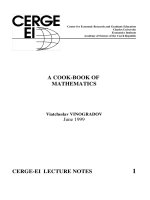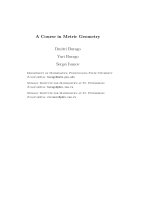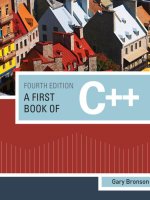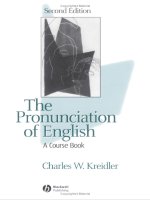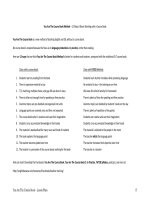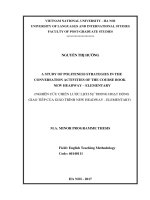semantics a course book
Bạn đang xem bản rút gọn của tài liệu. Xem và tải ngay bản đầy đủ của tài liệu tại đây (1.74 MB, 366 trang )
This page intentionally left blank
This practical coursebook introduces all the basics of semantics in a simple, step-by-
step fashion. Each unit includes short sections of explanation with examples, followed
by stimulating practice exercises to complete the book. Feedback and comment
sections follow each exercise to enable students to monitor their progress. No previous
background in semantics is assumed, as students begin by discovering the value and
fascination of the subject and then move through all key topics in the field, including
sense and reference, simple logic, word meaning, and interpersonal meaning. New
study guides and exercises have been added to the end of each unit (with online
answer key) to help reinforce and test learning. A completely new unit on non-literal
language and metaphor, plus updates throughout the text, significantly expand the
scope of the original edition to bring it up-to-date with the modern teaching of
semantics for introductory courses in linguistics as well as intermediate students.
JAMES R. HURFORD
is Professor of General Linguistics, University of Edinburgh.
BRENDAN HEASLEY
is Consultant (Postgraduate Training), Sharjah Women’s
College, United Arab Emirates.
MICHAEL B. SMITH is Associate Professor of Linguistics, Oakland University.
Semantics
A Coursebook
SECOND EDITION
JAMES R. HURFORD
Professor of General Linguistics, University of Edinburgh
BRENDAN HEASLEY
Consultant (Postgraduate Training), Sharjah Women’s College, United Arab Emirates
MICHAEL B. SMITH
Associate Professor of Linguistics, Oakland University
CAMBRIDGE UNIVERSITY PRESS
Cambridge, New York, Melbourne, Madrid, Cape Town, Singapore, São Paulo
Cambridge University Press
The Edinburgh Building, Cambridge CB2 8RU, UK
First published in print format
ISBN-13 978-0-521-67187-3
ISBN-13 978-0-511-28489-2
© James R. Hurford, Brendan Heasley, and Michael B. Smith 2007
2007
Information on this title: www.cambridge.org/9780521671873
This publication is in copyright. Subject to statutory exception and to the provision of
relevant collective licensing agreements, no reproduction of any part may take place
without the written
p
ermission of Cambrid
g
e University Press.
ISBN-10 0-511-28489-6
ISBN-10 0-521-67187-6
Cambridge University Press has no responsibility for the persistence or accuracy of urls
for external or third-party internet websites referred to in this publication, and does not
g
uarantee that any content on such websites is, or will remain, accurate or a
pp
ro
p
riate.
Published in the United States of America by Cambridge University Press, New York
www.cambridge.org
paperback
eBook (EBL)
eBook (EBL)
paperback
To S ue and Hilda, respectively
James R. Hurford
Brendan Heasley
To my parents
Michael B. Smith
vii
CONTENTS
Prefaces ix
Acknowledgements xi
How to use this book xii
1 Basic ideas in semantics 1
UNIT 1 About semantics 1
UNIT 2 Sentences, utterances, and propositions 16
UNIT 3 Reference and sense 26
2 From reference . . . 36
UNIT 4 Referring expressions 36
UNIT 5 Predicates 45
UNIT 6 Predicates, referring expressions, and universe of discourse 56
UNIT 7 Deixis and definiteness 65
UNIT 8 Words and things: extensions and prototypes 79
3 to sense 93
UNIT 9 Sense properties and stereotypes 93
UNIT 10 Sense relations (1) 105
UNIT 11 Sense relations (2) 120
4 Logic 141
UNIT 12 About logic 141
UNIT 13 A notation for simple propositions 152
UNIT 14 Connectives: and and or 164
UNIT 15 More connectives 180
5 Word meaning 194
UNIT 16 About dictionaries 194
UNIT 17 Meaning postulates 205
UNIT 18 Properties of predicates 218
UNIT 19 Derivation 225
UNIT 20 Participant roles 244
Contents
viii
6 Interpersonal and non-literal meaning 260
UNIT 21 Speech acts 260
UNIT 22 Perlocutions and illocutions 269
UNIT 23 Felicity conditions 281
UNIT 24 Direct and indirect illocutions 289
UNIT 25 Propositions and illocutions 303
UNIT 26 Conversational implicature 314
UNIT 27 Non-literal meaning: idioms, metaphor, and metonymy 327
Selected references and recommendations for further study 345
Index 347
ix
PREFACE TO THE SECOND EDITION
This new edition of the text is still aimed at the same introductory audience as
the first edition (as described in the preface to the first edition below). Most
units contain minor changes in the form of extra examples or brief additions to
the text that I feel help make the presentation of topics clearer. A major add-
ition of this new edition is the set of exercises and questions at the end of each
unit, which I developed over the years when I used the book in an introductory
semantics course at Oakland University in Rochester, Michigan. In many cases
they parallel similar practices in the first edition of the textbook, but there are
often additional exercises and study questions that go beyond this earlier
material in order to encourage the student to think about the issues from a
somewhat broader perspective. The frequent practices have been kept and occa-
sionally revised or extended in the new edition. I have not provided answers
(feedback) to the new end-of-unit questions in the text itself. This is to encour-
age students and instructors to seek answers on their own without the easy
temptation of looking them up at the back of the book. Suggested answers to
most of these new exercises and questions are provided in a separate online
answer key for qualified instructors (see www.cambridge.org/9780521671873).
While I agree with and have adhered to the selection of topics in the first
edition, I have nevertheless tried to briefly expand or update a few sections of
the text by adding selected introductory material and references on other
aspects of semantics that were not included in the first edition, but which have
become increasingly important in the field since that time. Consequently, I
have included new discussion of topics from cognitive semantics in Units 8
through 11, which I think is accessible and of interest to an introductory audi-
ence, including additional basic material on polysemy in Unit 11, and an
entirely new Unit (27) on idiomatic language, metaphor, and metonymy at the
end of the book. Additional discussion was also added in parts of Unit 16
about the differences between dictionaries and encyclopaedias and why this
distinction is important in semantics. The discussion of derivation in Unit 19
has been substantially expanded beyond the treatment of this topic in the first
edition to include more detailed information about morphology and its rela-
tion to meaning. I have also added material on participant (thematic) roles in
Unit 20, including an introduction to the roles of possessor and experiencer.
With the exception of the new Unit 27, I decided to integrate this new material
Prefaces
x
into appropriate existing units of the text to maintain, as far as possible, the
organization of the original edition of the book, which I think is quite clear
and well-designed. Finally, I have also updated and expanded the recommen-
dations for further study at the end of the book.
Clarifying text, examples, and exercises have been added to the end of
each unit.
Michael B. Smith
Department of Linguistics
Oakland University
PREFACE TO THE FIRST EDITION
This book presents a standard and relatively orthodox view of modern linguis-
tic semantics in what we hope is a clear, stimulating, and accessible format. Our
emphasis is on getting the student at every stage to think for himself, and so to
proceed through the development of concepts in semantics with the confidence
and conviction that comes from doing practical exercises with them. The
student should not skim the practice exercises, but should try to write down the
answers to each batch of questions before consulting the answers given in feed-
back. The labelling in the text of definitions, examples, comments, etc. should
help the student to find his way around in our exposition with ease. The entry
tests at the beginning of each unit should be taken seriously: they provide a way
for the student to judge his own progress at each stage.
The book is suitable for first-year undergraduates in linguistics and will
probably be useful to somewhat more advanced students for revision purposes.
We believe that it will also be possible for a person working independently to
teach himself the elements of semantics with this book. For students in taught
courses, each unit, or couple of units, could provide a good basis for small-
group discussion. Students should complete the units first, and discussion can
focus on developing interesting and/or problematic aspects of the material.
No elementary textbook can cover everything that its authors would have
wished to cover. We have been obliged to omit a number of interesting topics,
including ‘thematic meaning’ (topic, comment, etc.), quantification in logic,
tense and aspect, and the relation between syntax and semantics. We hope that
the student’s appetite will be sufficiently whetted by what we have covered to
lead him to take an active interest in these and other more advanced topics in
semantics.
xi
ACKNOWLEDGEMENTS (SECOND EDITION)
I would like to express my gratitude to the original authors, James R. Hurford
and Brendan Heasley, for entrusting me with the revision and updating of their
textbook.
I would also like to thank Andrew Winnard and Cambridge University Press
for inviting me to do the work in the first place.
Michael B. Smith
Department of Linguistics
Oakland University
ACKNOWLEDGEMENTS (FIRST EDITION)
We w ish to express our gratitude to:
The Nuffield Foundation for two grants of £3,000 which paid part of the salary
of one of the authors for two years.
The Edinburgh University Institute for Applied Language Studies and its
Director, Dr Clive Criper, for generous material support in the production of
this book.
The Edinburgh University Faculty of Arts research fund for grants to pay for
the typing of the book.
Professor John Lyons for extremely careful and detailed critical comments on
virtually the whole of the book, comments which, in the many cases where we
have heeded them, definitely improve the book. In the few cases where we have
not followed his advice, we fear that we may yet regret it.
The following colleagues and students, who have given helpful advice and
comments: John Christie, Gill Brown, Charles Fillmore, Gerald Gazdar,
Deirdre Wilson, Steve Pulman, Keith Brown.
Jaime Lass for the drawings.
xii
HOW TO USE THIS BOOK
For all Users The coursebook develops information on the subject cumulatively. Each unit
builds on previous units, so it is wise to work through it systematically from
the beginning. Skipping ahead, or dipping into later units, may work, but is
less likely to build up a good solid foundation for understanding all the
concepts involved.
For the Student If you are new to semantics, take the practice exercises seriously, writing the
answers in the spaces provided, and checking your answers with the feedback
given. If there is a discrepancy between your answer and the feedback given,
revisit the explanations in the book to try to understand where you went
wrong. Semantics is not such a cut-and-dried subject as, say, chemistry or
mathematics, so there is sometimes room for alternative answers and
interpretations. But we have tried hard in this book to use unproblematic and
uncontroversial examples, on which all advanced semanticists would be in
broad agreement.
It always helps understanding to talk about things, so if you can work through
any problematic cases with a fellow student or with your teacher, we strongly
advise you to do so. As authors, we occasionally get letters from students asking
us to resolve disagreements about their answers. So it is clear that the exercises
provoke discussion, and also that sometimes a student needs some outside help
in seeing an issue clearly. (Most of our letters from users of this book, however,
seem to show that it has been successful in getting its main concepts across.)
For the Teacher We assume that you will be at least one step ahead of your students, and
already familiar with more of the literature on semantics than just this book.
This book is just a beginning. The further readings recommended at the end
of the book open up the field to a host of intriguing questions, some of a
very philosophical nature, and some of a more practical nature, to do with
the study of meaning. Aim to get your students to see the concepts outlined
in this book not just as ends in themselves, to be mastered rote-fashion, but
as giving them a set of agreed-upon tools for discussing more advanced
issues of meaning in language.
Understanding the mechanisms of meaning is vital to successful human
communication, so convey to your students the everyday significance of the
How to use this book
xiii
examples. Most of the time, the students’ intuitions about the meanings of
words, sentences, and utterances will be sound and consistent, but they lack
the terminology to discuss meanings systematically. As noted above in our
advice to students, discussion usually helps to clarify issues. Approach the
questions asked by your students with an open mind, aiming to see how any
misunderstandings may have arisen. And always be prepared to admit that
some of the basic exercises in this book are not, ultimately, susceptible to
quite such cut-and-dried answers as we have given. That is not to say that
questions in semantics can’t be resolved by sensible discussion, but just that
the answers may sometimes be more subtle, and more interesting, than some
of the cut-and-dried sample feedback answers that we have given.
1
1 Basic ideas in semantics
UNIT 1 ABOUT SEMANTICS
Definition SEMANTICS is the study of MEANING in LANGUAGE.
Comment The rest of this book can be regarded as an example of how one goes about
investigating and understanding semantics. It may seem to you that meaning
is so vague, insubstantial, and elusive that it is impossible to come to any
clear, concrete, or tangible conclusions about it. We hope to convince you
that by careful thought about the language you speak and the way it is used,
definite conclusions CAN be arrived at concerning meaning. In the first
exercise below, we ask you to start to get yourself into the habit of careful
thinking about your language and the way you use it, concentrating,
naturally, on instances of such words as mean, means, and meaning.
Practice Reproduced below is a well-known passage from Lewis Carroll’s Through the
Looking Glass. Pick out all the instances of the word mean (or means,or
meant), noting which lines they occur in. (Some line numbers are given in
the margin for convenience.) After the passage there are some questions for
you to answer.
1 ‘. . . that shows that there are three hundred and sixty-four days
when you might get un-birthday presents.’
‘Certainly,’ said Alice.
‘And only one for birthday presents, you know. There’s glory for
5you!’
‘I don’t know what you mean by “glory,”’ Alice said.
Humpty Dumpty smiled contemptuously.‘Of course you don’t –
till I tell you. I meant “there’s a nice knockdown argument for you.”’
‘But “glory” doesn’t mean ‘a nice knockdown argument,’ Alice
10 objected.
‘When I use a word,’ Humpty Dumpty said in rather a scornful
tone, ‘it means just what I choose it to mean – neither more nor less.’
‘The question is,’ said Alice, ‘whether you can make words mean
so many different things.’
15 ‘The question is,’ said Humpty Dumpty,‘which is to be master –
that’s all.’
PART ONE
Basic ideas in semantics
2
(1) What word is the subject of the verb mean in line 6?
(2) What is the subject of the verb mean in line 9?
(3) What is understood as the subject of the verb mean in line 12?
(4) List all the instances (by line number) where mean, means,or meant has
a personal subject, e.g. I or you.(Include instances already listed in the
questions above.)
(5) List all the instances (by line number) in which mean,or means,or
meant is understood as having as subject something linguistic, e.g. a
word,or words. (Include instances mentioned in questions above.)
Feedback (1) you (2) the word glory (3) it, or a word (4) lines 6, 8 (5) lines 9, 12, 12, 13
Comment
Lewis Carroll had brilliant insights into the nature of meaning (and into the
foibles of people who theorize about it). In the passage above, he is playfully
suggesting that the meanings carried by words may be affected by a speaker’s
will. On the whole, we probably feel that Alice is right, that words mean what
they mean independently of the will of their users, but on the other hand it
would be foolish to dismiss entirely Humpty Dumpty’s enigmatic final remark.
Lewis Carroll’s aim was to amuse, and he could afford to be enigmatic and
even nonsensical. The aim of serious semanticists is to explain and clarify the
nature of meaning. For better or for worse, this puts us in a different literary
genre from Through the Looking Glass.The time has come to talk seriously of
meaning.
Practice (1) Do the following two English sentences mean (approximately)
the same thing? Yes / No
I’ll be back later and I will return after some time
(2) Is the answer to the previous question obvious to a normal
speaker of English? Yes / No
(3) In the light of your reply to (2), if I ask ‘What did John mean
when he said he’d be back later?’, would you be giving the
helpful kind of answer that I probably want if you said ‘He
meant that he would return after some time’? Yes / No
(4) In asking ‘What did John mean when he said he’d be back
later?’ is the questioner primarily asking
(a) what the SENTENCE I’ll be back later means, or
(b) what JOHN meant in saying it? (a) / (b)
(5) A dictionary can be thought of as a list of the meanings
of words, of what words mean. Could one make a list of
what speakers (e.g. John, you, or I) mean? Yes / No
(6) Do you understand this question? Yes / No
Feedback (1) Yes (2) Yes (3) No, this would be a statement of the obvious, and
therefore unhelpful. (4) asking what JOHN meant in saying it, most usually.
(5) No, speakers may mean different things on different occasions, even when
using the same words. (6) Assuming you are a competent English speaker,
yes, you do understand the literal meaning of the interrogative sentence in
question (6); but at the same time you may not clearly understand what we,
the authors, mean in asking you this question. We mean to point out that
understanding, like meaning, can be taken in (at least) two different ways.
Comment The word mean, then, can be applied to people who use language, i.e. to
speakers (and authors), in roughly the sense of ‘intend’. And it can be
applied to words and sentences in a different sense, roughly expressed as ‘be
equivalent to’. The first step in working out a theory of what meaning is, is
to recognize this distinction clearly and always to keep in mind whether we
are talking about what speakers mean or what words (or sentences) mean.
The following two definitions encapsulate this essential distinction.
Definition SPEAKER MEANING is what a speaker means (i.e. intends to convey) when
he uses a piece of language.
SENTENCE MEANING (or WORD MEANING) is what a sentence (or
word) means, i.e. what it counts as the equivalent of in the language concerned.
Comment The distinction is useful in analysing the various kinds of communication
between people made possible by language.
Practice Read the following conversation between two people, A and B, at a bus stop
one morning. (The lines are numbered for reference.) Then answer the
questions (1)–(8).
1 A: ‘Nice day’
2 B: ‘Yes, a bit warmer than yesterday, isn’t it?’
3 A: ‘That’s right – one day fine, the next cooler’
4 B: ‘I expect it might get cooler again tomorrow’
5 A: ‘Maybe – you never know what to expect, do you?’
6 B: ‘No. Have you been away on holiday?’
7 A: ‘Yes, we went to Spain’
8 B: ‘Did you? We’re going to France next month’
UNIT 1
About semantics
3
PART ONE
Basic ideas in semantics
4
9 A: ‘Oh. Are you? That’ll be nice for the family. Do they speak French?’
10 B: ‘Sheila’s quite good at it, and we’re hoping Martin will improve’
11 A: ‘I expect he will. I do hope you have a good time’
12 B: ‘Thank you. By the way, has the 42 bus gone by yet? It seems to be late’
13 A: ‘No. I’ve been here since eight o’clock and I haven’t seen it’
14 B: ‘Good. I don’t want to be late for work. What time is it now?’
15 A: ‘Twenty-five past eight’
(1) Does speaker A tell speaker B anything he doesn’t already
know in lines 1, 3, and 5? Yes / No
(2) Does A’s statement in line 7 give B any new information? Yes / No
(3) When B says ‘Did you?’ in line 8, is he really asking A to tell
him whether he (A) went to Spain? Yes / No
(4) Is there any indication that A needs to know the information
that B gives him about travelling to France? Yes / No
(5) Does A’s ‘That’ll be nice for the family’ in line 9 give B any
information? Yes / No
(6) Do A’s statements in lines 13 and 15 give B any information
that he (B) needs? Yes / No
(7) At what point does this conversation switch from an exchange of
uninformative statements to an exchange of informative statements?
(8) At what point does the information exchanged begin to be of a sort that
one of the speakers actually needs for some purpose in going about his
everyday business?
Feedback (1) probably not (2) Yes, probably (3) No (4) No (5) probably not (6) Yes
(7) with B’s enquiry in line 6 (8) with B’s question in line 12
Comment All the things said in this conversation are meaningful in one way or another.
But one must not equate meaningfulness with informativeness in a narrow
sense. While it is true that many sentences do carry information in a
straightforward way, it is also true that many sentences are used by speakers
not to give information at all, but to keep the social wheels turning smoothly.
Thus A and B’s uninformative exchange about the weather serves to reassure
them both that a friendly courteous relationship exists between them. Even
when the sentences produced are in fact informative, as when B tells A about
his forthcoming trip to France, the hearer often has no specific need for the
information given. The giving of information is itself an act of courtesy,
performed to strengthen social relationships. This is also part of
communication.
UNIT 1
About semantics
5
The social relationships formed and maintained by the use of language are
not all courteous and amicable. Speaker meaning can include both courtesy
and hostility, praise and insult, endearment and taunt.
Practice Consider the following strained exchange between husband and wife. Then
answer the questions (1)–(8).
Husband: ‘When I go away next week, I’m taking the car’
Wife: ‘Oh. Are you? I need the car here to take the kids to school’
Husband: ‘I’m sorry, but I must have it. You’ll have to send them on the bus’
Wife: ‘That’ll be nice for the family. Up at the crack of dawn,
(ironically) and not home till mid-evening! Sometimes you’re
very inconsiderate’
Husband: ‘Nice day’
(1) This conversation includes three utterances which were also used in the
polite bus stop conversation between A and B. Identify these three
utterances.
(2) When the wife in the above exchange says ‘Are you?’ is she thereby in
some sense taking up a position opposed to that of her husband? Ye s / No
(3) In the bus stop conversation, when A says ‘Are you?’ (line 9),
is he in any sense taking up a position opposed to B’s position? Yes / No
(4) When the wife, above, says ‘That’ll be nice for the family’, is
she expressing the belief that her husband’s absence with the
car will be nice for the family? Yes / No
(5) When A says to B at the bus stop ‘That’ll be nice for the
family’, is he expressing the belief that going to France will
be nice for the family? Yes / No
(6) Is A’s remark at the bus stop ‘Nice day’ a pointed change of
subject for the purpose of ending a conversation? Yes / No
(7) What is the function of this remark of A’s?
(8) When the husband uses these same words about the weather, above,
what does he mean by it?
Feedback (1) ‘Are you?’,‘That’ll be nice for the family’, and ‘Nice day’ (2) Yes (3) No
(4) No, she is probably being sarcastic (5) Yes (6) No (7) part of a polite
prelude to more interesting conversation (8) In the husband’s case, the
remark is used to end a conversation, rather than initiate one.
PART ONE
Basic ideas in semantics
6
Comment The same sentences are used by different speakers on different occasions
to mean (speaker meaning) different things. Once a person has mastered the
stable meanings of words and sentences as defined by the language system,
he can quickly grasp the different conversational and social uses that they can
be put to. Sentence meaning and speaker meaning are both important, but
systematic study proceeds more easily if one carefully distinguishes the two,
and, for the most part, gives prior consideration to sentence meaning and
those aspects of meaning generally which are determined by the language
system, rather than those which reflect the will of individual speakers and the
circumstances of use on particular occasions.
The gap between speaker meaning and sentence meaning is such that it is
even possible for a speaker to convey a quite intelligible intention by using a
sentence whose literal meaning is contradictory or nonsensical.
Practice Look at the following utterances and state whether they are intended to be
taken literally (Yes ) or not (No).
(1) Tired traveller: ‘This suitcase is killing me’ Yes / No
(2) Assistant in a shop: ‘We regularly do the impossible;
miracles take a little longer’ Yes / No
(3) During a business meeting: ‘It’s a dog-eat-dog situation’ Yes / No
(4) During a heated argument: ‘Don’t bite my head off!’ Yes / No
(5) Hungry person at the dinner table: ‘I could eat a horse!’ Yes / No
Feedback (1) No (2) No (3) No (4) No (5) No
Comment Examples such as these show that speakers can convey meaning quite
vividlybyusing sentences whose meanings are in some sense problematical.
To account for this, it is necessary to analyse at two levels: firstly, to show
what is ‘wrong’ with such sentences, i.e. why they can’t be literally true,
and secondly, how speakers nevertheless manage to communicate
something by means of them. Sections of this book are devoted to both
kinds of meaning, but rather more attention is given to sentence and word
meaning.
We will now leave this topic and give some attention to the question of
how one studies meaning – to the methods of semantics.
Practice (1) Can two people hold an ordinary conversation without
knowing the meanings of the words they are using? Yes / No
(2) Is it reasonable to say, if I use such English words as table and
chair in the normal way in my conversation, communicating
the usual messages that one does with these and other words,
that I know the meanings of the words table and chair? Yes / No
UNIT 1
About semantics
7
(3) If one knows the meaning of a word, is one therefore
necessarily able to produce a clear and precise definition
of its meaning? Yes / No
(4) Conversely, if several speakers can agree on the correct
definition of a word, do they know its meaning? Yes / No
(5) Do you happen to know the meaning of the word ndoho in
the Sar language of Chad, Central Africa? Yes / No
(6) Would a sensible way to find out the meaning of ndoho be
to ask a speaker of Sar (assuming you could find one)? Yes / No
(7) The word ndoho in Sar means nine, so it is not a particularly
rare or technical word. Would any normal adult speaker of
Sar be an appropriate person to approach to ask the meaning
of the word? Yes / No
(8) If a native speaker of Sar insists that ndoho means nine (or the number
of digits on two hands, less one, or however he expresses it), while a
distinguished European professor of semantics who does not speak Sar
insists that ndoho means ten (or dix,or zehn,however he translates it),
who do you believe, the Sar-speaker or the professor?
Feedback (1) No (2) Yes (3) No, being able to give the definition of the meaning of a
word is not a skill that everyone possesses. (Studying semantics should
considerably sharpen this skill.) (4) Yes, it would seem reasonable to say
so. (5) Probably you don’t. (6) Yes (7) Yes, although some speakers,
possibly through shyness or embarrassment, might not be able to give you
a perfectly clear answer. (8) the Sar-speaker
Comment The meanings of words and sentences in a language can safely be taken as
known to competent speakers of the language. Native speakers of languages
are the primary source of information about meaning. The student (or the
professor) of semantics may well be good at describing meanings, or
theorizing about meaning in general, but he has no advantage over any
normal speaker of a language in the matter of access to the basic data
concerning meaning.
English, like most languages, has a number of different dialects. Just as the
pronunciation of English varies from one dialect to another, so there are also
differences in the basic semantic facts from one dialect of English to another.
Note that we are using ‘dialect’ in the way normal in Linguistics, i.e. to indicate
any variety of a language, regardless of whether it has prestige or not. In this
sense, every speaker, from the London stockbroker to the Californian surfer
speaks some dialect.
PART ONE
Basic ideas in semantics
8
It is not the business of semantics to lay down standards of semantic
correctness, to prescribe what meanings words shall have, or what they may
be used for. Semantics, like the rest of Linguistics, describes. If some of the
basic semantic facts mentioned in this book don’t apply to your dialect, this
doesn’t mean that your dialect is in any sense wrong. Try to see the point of
such examples on the assumption that they are factual for some dialect of
English other than your own.
Almost all of the examples in this book will be from standard English.
We assume that most readers are native speakers of English and hence know
the meanings of English expressions. This may seem paradoxical: if semantics
is the study of meaning, and speakers already know the meanings of all the
expressions in their language, surely they cannot learn anything from
semantics! What can a book written for English speakers, using English
examples, tell its readers? The answer is that semantics is an attempt to set
up a theory of meaning.
Definition A THEORY is a precisely specified, coherent, and economical frame-work of
interdependent statements and definitions, constructed so that as large a
number as possible of particular basic facts can either be seen to follow from
it or be describable in terms of it.
Example Chemical theory, with its definitions of the elements in terms of the periodic
table, specifying the structure of atoms, and defining various types of
reactions that can take place between elements, is a theory fitting the above
definition. Examples of some basic facts which either follow from chemical
theory itself or are describable in terms of it are: iron rusts in water; salt
dissolves in water; nothing can burn if completely immersed in water; lead is
heavier than aluminium; neither aluminium nor lead float in water. Chemical
theory, by defining the elements iron, lead, etc., and the reactions commonly
known as rusting, burning, dissolving, etc., in terms of atomic structure,
makes sense of what would otherwise simply be an unstructured list of
apparently unrelated facts.
In the practice section below we illustrate some particular basic facts
about meaning, the kind of facts that a complete semantic theory must make
sense of.
Practice Mark each of the following statements true (T) or false (F).
(1) Alive means the opposite of dead. T / F
(2) Buy has an opposite meaning from sell. T / F
(3) Caesar is and is not a meaningful English sentence. T / F
(4) Caesar is a prime number is nonsensical. T / F
(5) Caesar is a man is nonsensical. T / F
(6) Both of John’s parents are married to aunts of mine is in a sense
contradictory, describing an impossible situation. T / F
(7) If the sentence John killed Bill is true of any situation, then so
is the sentence Bill is alive. T / F
(8) If someone says, ‘Can you pass the salt?’, he is normally not
asking about his hearer’s ability to pass the salt, but requesting
the hearer to pass the salt. T / F
(9) If someone says, ‘I tried to buy some rice’, his hearer would
normally infer that he had actually failed to buy rice. T / F
Feedback (1)T (2)T (3)T (4)T (5)F (6)T (7)F (8)T (9)T
Comment Each of the true statements here (and the negation of the false ones) is a
statement of some particular basic fact falling within the scope of semantics.
(We take a rather broad view of the scope of semantics, incidentally.)
Obviously, one could not expect chemical theory, for example, to illuminate
any of these facts. Chemical theory deals with chemical facts, such as the
fact that iron rusts in water. Semantic theory deals with semantic facts,
facts about meaning, such as those stated in the true statements above.
In aiming to discover some system and pattern in an assortment of
particular facts about the meanings of individual words, sentences, and
utterances, it is obviously necessary to try to move from particular facts, such
as those mentioned above, to generalizations, i.e. statements about whole
classes of items.
Practice Think carefully about each of the following general statements, and try to say
whether it is true (T) or false (F).
(1) Proper names (like English John or German Hans or French
Jean) have a different kind of meaning from common nouns
(like English man,or German Mann or French homme). T / F
(2) Prepositions (like English under,or German unter,or French
sous) have a different kind of meaning from both proper
names and common nouns. T / F
(3) Conjunctions (like English and or German und,or French
et) have yet a further kind of meaning from both proper
names and common nouns, and prepositions. T / F
(4) Articles (e.g. English the,German der,or French le) have a
different kind of meaning from proper names, common
nouns, prepositions, and conjunctions. T / F
Feedback (1)T (2)T (3)T (4)T
UNIT 1
About semantics
9


